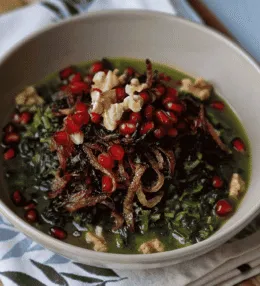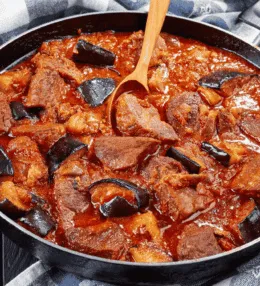
- View
Table of Contents
ToggleLong before oxtail became a trendy ingredient in upscale restaurants, British cooks understood the magic that happens when you simmer this bony, gelatinous cut for hours until it surrenders every bit of flavour into a rich, warming broth. Oxtail soup represents British cooking at its practical best.
Nothing went to waste in traditional British kitchens, and the tail of a cow, though awkward and bony, could produce a soup so deeply satisfying that it graced both working class tables and aristocratic dining rooms. This is peasant food that earned respect across all social boundaries.
The soup gained such popularity in Britain that it became a staple tinned product, sitting on pantry shelves alongside other household essentials. Yet the homemade version tells a different story entirely, one of patience rewarded with layers of meaty, savoury depth that no factory production could replicate.
What makes oxtail soup particularly British is the way it reflects the nation’s talent for extracting maximum value from minimal resources. This wasn’t about making do with scraps but rather recognising that some of the finest flavours hide in the cuts that require time and skill to unlock.
Want to dive deeper into British Cuisine? Don’t miss our post on Traditional British Foods to Try
What Is Oxtail Soup?
Oxtail soup is a slow cooked dish built around sections of cow’s tail, which are simmered with vegetables and herbs until the meat falls away from the bone and the collagen transforms into a silky, body rich broth. The result sits somewhere between a chunky soup and a light stew.
The preparation requires little technique but demands considerable time. The tail pieces need browning first to develop colour and depth, then they simmer gently for three to four hours, sometimes longer. This extended cooking breaks down the tough connective tissue into gelatine.
As the soup cools, that gelatine gives it an almost jelly-like consistency, which melts back into liquid silk when reheated. This quality separates oxtail soup from thinner broths and gives it a coating, luxurious mouthfeel that feels far more expensive than its humble origins suggest.
Many cooks prepare oxtail soup a day ahead, allowing the fat to solidify on top overnight for easy removal. This step isn’t just about reducing richness but also about clarifying the flavours, letting the true taste of the beef and vegetables shine through without greasiness.
Ingredients and Taste
The oxtail pieces themselves form the heart of the dish, typically cut into rounds that show the cross section of tail bone surrounded by meat and fat. Onions, carrots and celery create the vegetable base, their sweetness balancing the deep meatiness of the beef.
Bay leaves, thyme and parsley add herbal notes without overwhelming the primary flavour. Some recipes include turnips or leeks for additional vegetable character. A splash of red wine or a spoonful of tomato purée can deepen the colour and add subtle acidity to cut through the richness.
Beef stock or water forms the cooking liquid, though by the time the soup finishes simmering, the oxtail has contributed so much flavour that the choice between the two matters less than you might expect. Salt and black pepper remain the primary seasonings, allowing the natural beef taste to dominate.
The flavour of oxtail soup is profoundly beefy, richer and more complex than soup made from lean cuts. Each spoonful delivers tender shreds of meat that have absorbed the aromatic vegetables and herbs, whilst the broth itself coats your tongue with savoury depth.
The texture varies depending on whether you strain the soup or serve it chunky. Traditional versions often include the vegetables and meat pieces, creating a hearty dish that needs only bread to make a complete meal. The gelatinous quality gives body without heaviness, making it simultaneously filling and comforting.
A Taste of History
Oxtail soup has roots stretching back centuries in British cookery, appearing in recipe collections from the 1700s onwards. The dish emerged from the practical necessity of using every part of a butchered animal, with tails being particularly cheap because they required such lengthy cooking.
French Huguenot refugees fleeing to England in the 17th century brought sophisticated cooking techniques that influenced British approaches to previously overlooked cuts. They demonstrated how patient simmering could transform tough, bony pieces into dishes worthy of any table, elevating oxtail from mere survival food.
By Victorian times, oxtail soup had become a staple in British households across the economic spectrum. Mrs Beeton’s famous cookbook included recipes for it, cementing its place in the national repertoire. The soup appeared at grand dinners and modest family suppers alike, proving its versatility.
The 20th century saw tinned oxtail soup become enormously popular in Britain, with several brands offering their versions. This convenience product introduced generations to the flavour, though it bore only passing resemblance to the homemade original in terms of texture and depth.
Today, oxtail has become an expensive cut as more cooks rediscover its qualities. What was once a budget option now commands premium prices, though the soup remains worth making for anyone wanting to experience British cooking’s resourceful, flavour driven traditions at their finest.
How to Make Oxtail Soup
Oxtail soup is a beloved British classic, slow cooked to perfection for a deeply rich and hearty flavour. The meat becomes beautifully tender while the broth thickens into a silky stew, perfect for cold days. Patience is key, as slow cooking draws out the marrow’s natural depth and warmth. See the recipe card at the bottom for printable directions
Ingredients
- 1.2 kg oxtail, cut into sections
- 2 tbsp plain flour
- 2 tbsp vegetable oil or beef dripping
- 1 large onion, finely chopped
- 2 carrots, diced
- 2 celery sticks, chopped
- 2 cloves garlic, crushed
- 1 tbsp tomato purée
- 1 bay leaf
- 2 sprigs fresh thyme (or ½ tsp dried thyme)
- 1.2 litres beef stock (preferably homemade)
- 250 ml red wine (optional but traditional)
- 1 tbsp Worcestershire sauce
- Salt and freshly ground black pepper, to taste
- 1 tbsp fresh parsley, chopped (for garnish)
Cooking Instructions
Step 1: Prepare the oxtail
Pat the oxtail pieces dry with kitchen paper and season lightly with salt and pepper. Dust them with plain flour to help with browning and thickening later. This small step enhances both colour and flavour.
Step 2: Brown the oxtail
Heat the oil or dripping in a large, heavy based casserole over medium to high heat. Add the oxtail pieces in batches, browning them evenly on all sides. Do not overcrowd the pan. Remove and set aside once browned.
Step 3: Sauté the vegetables
In the same pot, lower the heat slightly and add the onion, carrots, and celery. Cook for about 8 minutes until softened and golden, stirring occasionally to prevent sticking. Add the crushed garlic and cook for another minute until aromatic.
Step 4: Add tomato purée and wine
Stir in the tomato purée and cook for a further 2 minutes to remove its raw edge. Pour in the red wine, scraping up the caramelised bits from the bottom of the pan. Allow it to simmer for 5 minutes until slightly reduced.
Step 5: Build the stew base
Return the browned oxtail to the pot. Add the bay leaf, thyme, beef stock, and Worcestershire sauce. Bring the mixture to a gentle boil, then reduce to a low simmer.
Step 6: Slow cook to tenderness
Cover the pot with a tight-fitting lid and transfer it to a preheated oven at 160°C. Cook for 3 to 3½ hours until the meat is falling off the bone tender. Halfway through, skim off any surface fat for a cleaner broth.
Step 7: Strain and refine
Once cooked, carefully remove the oxtail pieces and set aside. Strain the soup through a fine sieve into another pot to achieve a smooth texture, pressing the vegetables to extract their flavour.
Step 8: Shred the meat
Allow the oxtail to cool slightly, then remove the meat from the bones and discard the fat and gristle. Return the shredded meat to the strained soup.
Step 9: Adjust seasoning and thicken
Simmer the soup gently on the hob for 10 minutes. If desired, mix a teaspoon of flour with a little cold water and stir in to thicken slightly. Taste and adjust with salt, pepper, or a splash more Worcestershire sauce.
Step 10: Serve and garnish
Ladle the soup into warm bowls and sprinkle with chopped parsley. Serve with crusty bread or buttered rolls to soak up the rich, velvety broth. The flavours deepen further when reheated the next day.
Variations and Substitutions
- Wine substitute: Use extra beef stock with a splash of malt vinegar if you prefer to omit alcohol.
- Thyme: Substitute with rosemary or parsley for a different herbal note.
- Vegetable boost: Add diced parsnip or turnip for a sweeter edge.
- Flour alternative: Cornflour mixed with water can replace plain flour for gluten free thickening.
Cooking Tips for Perfect Oxtail Soup
- Brown the oxtail thoroughly to build a deep, savoury base.
- Skim fat during cooking for a cleaner and more refined broth.
- Cook low and slow; rushing will toughen the meat.
- Let the soup rest overnight in the fridge to develop richer flavour.
- Reheat gently, stirring occasionally to keep the meat tender.

English Oxtail Soup (Beef and Bone Broth)
Ingredients
- 1.2 kg oxtail cut into sections
- 2 tbsp plain flour
- 2 tbsp vegetable oil or beef dripping
- 1 large onion finely chopped
- 2 carrots diced
- 2 celery sticks chopped
- 2 cloves garlic crushed
- 1 tbsp tomato purée
- 1 bay leaf
- 2 sprigs fresh thyme or ½ tsp dried thyme
- 1.2 litres beef stock preferably homemade
- 250 ml red wine optional but traditional
- 1 tbsp Worcestershire sauce
- Salt and freshly ground black pepper to taste
- 1 tbsp fresh parsley chopped (for garnish)
Instructions
- Pat the oxtail pieces dry with kitchen paper and season lightly with salt and pepper. Dust them with plain flour to help with browning and thickening later. This small step enhances both colour and flavour.
- Heat the oil or dripping in a large, heavy based casserole over medium to high heat. Add the oxtail pieces in batches, browning them evenly on all sides. Do not overcrowd the pan. Remove and set aside once browned.
- In the same pot, lower the heat slightly and add the onion, carrots, and celery. Cook for about 8 minutes until softened and golden, stirring occasionally to prevent sticking. Add the crushed garlic and cook for another minute until aromatic.
- Stir in the tomato purée and cook for a further 2 minutes to remove its raw edge. Pour in the red wine, scraping up the caramelised bits from the bottom of the pan. Allow it to simmer for 5 minutes until slightly reduced.
- Return the browned oxtail to the pot. Add the bay leaf, thyme, beef stock, and Worcestershire sauce. Bring the mixture to a gentle boil, then reduce to a low simmer.
- Cover the pot with a tight-fitting lid and transfer it to a preheated oven at 160°C. Cook for 3 to 3½ hours until the meat is falling off the bone tender. Halfway through, skim off any surface fat for a cleaner broth.
- Once cooked, carefully remove the oxtail pieces and set aside. Strain the soup through a fine sieve into another pot to achieve a smooth texture, pressing the vegetables to extract their flavour.
- Allow the oxtail to cool slightly, then remove the meat from the bones and discard the fat and gristle. Return the shredded meat to the strained soup.
- Simmer the soup gently on the hob for 10 minutes. If desired, mix a teaspoon of flour with a little cold water and stir in to thicken slightly. Taste and adjust with salt, pepper, or a splash more Worcestershire sauce.
- Ladle the soup into warm bowls and sprinkle with chopped parsley. Serve with crusty bread or buttered rolls to soak up the rich, velvety broth. The flavours deepen further when reheated the next day.
Nutrition
You May Also Like







Leave a Review